Day-52 | Daily MCQs | UPSC Prelims | INDIAN GEOGRAPHY
| [WpProQuiz 58] |
| [WpProQuiz 58] |
THE CONTEXT: The Government of India has taken a monumental step towards addressing the challenges and problems they face, through the country’s first Pan-India toll-free helpline – 14567 — called ‘Elder Line’, which provides free information and guidance on pension issues, legal issues, extends emotional support, and even intervenes on the field in cases of abuse, and rescues homeless elderly.
ANALYSIS:
SOURCE: PIB
THE CONTEXT: The Prime Minister dedicated to the Nation 35 crop varieties with special traits. The Prime Minister also dedicated to the nation the newly constructed campus of the National Institute of Biotic Stress Management Raipur.
ANALYSIS:
ABOUT NATIONAL INSTITUTE OF BIOTIC STRESS MANAGEMENT
SOURCE: PIB
THE CONTEXT: The lockdowns slowed renewable energy installations in India and the pace of such installation is lagging India’s 2022 target, according to a report by the Institute for Energy Economics and Financial Analysis (IEE- FA), a research think tank.
ANALYSIS:
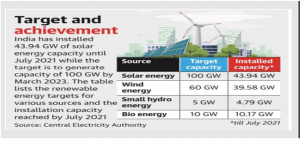
SOURCE: TH
THE CONTEXT: Road works totalling Rs. 1.5 lakh crore is being undertaken in the Union Territories of J & K and Ladakh. Minister for Road Transport and Highways reviewed the construction work at the Zojila tunnel, likely to be ready by September 2026.
ANALYSIS:
Mountain passes in India:

SOURCE: TH
THE CONTEXT: The two-day Dialogue leveraged as a platform to deliberate upon multiple ongoing collaborations in the health sector between the two countries.
ANALYSIS:
SOURCE: PIB
Q.Which of the following pairs is/are incorrectly matched?
Select the correct answer using the code given below:
a) 1 only
b) 1 and 2 only
c) 2 and 3 only
d) 1, 2 and 3
ANSWER: C)
Explanation:
| [WpProQuiz 57] |
THE CONTEXT: Prime Minister of India launched countrywide Ayushman Bharat Digital Mission.
ABOUT AYUSHMAN BHARAT DIGITAL MISSION
SOURCE: PIB
THE CONTEXT: Ministry of Housing & Urban Affairs (MoHUA) has organised the launch event of the Convergence between PM Formalisation of Micro-food processing Enterprises (PMFME)&Deendayal Antyodaya Yojana-National Urban Livelihoods Mission (DAY-NULM) scheme.
ANALYSIS:
SOURCE: PIB
THE CONTEXT: The Sundarbans mangrove ecosystem in India is evaluated as ‘endangered’ by a global team of researchers using the IUCN’s Red List of Ecosystems framework.
ANALYSIS:
SOURCE: MONGABAY
THE CONTEXT: India has emerged as Dubai’s second-biggest trading partner.
ANALYSIS:
SOURCE: TOI
THE CONTEXT: A new version of the Akash Missile – ‘Akash Prime’ has been successfully flight tested from Integrated Test Range (ITR), Chandipur.
ANALYSIS:
SOURCE: PIB
Q. Consider the following statements about Ayushman Bharat Digital Mission
Which of the statements given above is/are correct?
a) 1 only b) 2 only
c) Both 1 and 2 d) Neither 1 nor 2
Answer: C
Explanation:
| [WpProQuiz 56] |
THE CONTEXT: As many as 157 artefacts and antiquities were handed over by the United States during Prime Minister Narendra Modi’s visit to the country.
ANALYSIS:
SOURCE: IE
THE CONTEXT: Saubhagya completes four years of successful implementation 2.82 crore households have been electrified since the launch of Saubhagya.
ABOUT SAUBHAGYA
SOURCE: PIB
THE CONTEXT: The India Meteorological Department (IMD) said that Cyclone Gulab has weakened into a deep depression and moved westwards with a speed of 6 kmph during last the last few hours. Odisha evacuated about 40,000 people in six southern districts ahead of the storm.
NAMING OF TROPICAL CYCLONES IN NORTH INDIAN OCEAN
SOURCE:IE
THE CONTEXT: The Delhi Metro said it has earned Rs19.5 crores from sale of 3.55 million carbon credits collected over a period of six years from 2012 to 2018, in its bid towards gaining greater energy efficiency.
Analysis:
About Clean Development Mechanism (CDM)
Source: PIB
THE CONTEXT: Coir industry was concentrated in the State of Kerala, which has now been proliferated to other parts of the country also, with the efforts taken by the Board.
ABOUT COIR BOARD
COIR INDUSTRY IN INDIA
SOURCE:PIB
THE CONTEXT: Indian Prime Minister Narendra Modi addressed the 76th session of the United Nations General Assembly on September 25 with a powerful speech. During his address, PM Modi highlighted India’s progress and innovation in science, technology, healthcare, as well as the situation in Afghanistan, at the global stage.
MAJOR HIGHLIGHTS FROM MODI’S SPEECH AT UNGA
SOURCE: WIONEWS
THE CONTEXT: On September 24, President Biden hosted Prime Minister Scott Morrison of Australia, Prime Minister Narendra Modi of India, and Prime Minister Yoshihide Suga of Japan at the White House for the first-ever in-person Leaders’ Summit of the Quad.
ANALYSIS:
SOURCE: PIB
THE CONTEXT: President Joseph R. Biden welcomed Prime Minister Narendra Modi to the White House today for their first in-person Leaders’ engagement, renewing their close relationship and charting a new course to advance the partnership between the world’s largest democracies.
ANALYSIS:
SOURCE: PIB
Consider the following statements about Clean Development Mechanism (CDM):
Which of the statements given above is/are correct?
a) 1 only
b) 1 and 2 only
c) 2 and 3 only
d) 1, 2 and 3
Q1 Answer: c)
Explanation:
Q2Answer: c)
Explanation:
Characteristics of cryptocurrencies:
The term “cryptocurrency in itself is derived from the encryption techniques used to secure the network. Therefore, safe and secure transactions or payments.
[WpProQuiz 55]
THE CONTEXT: Ministry of Civil Aviation releases India’s airspace map for drone operations. The map is available on DGCA’s digital sky platform at https://digitalsky.dgca.gov.in/home.
WHY ARE DRONES IMPORTANT?
WHAT’S THE LIKELY IMPACT OF THESE DRONE INITIATIVES?
TOP 10 FEATURES OF THE DRONE AIRSPACE MAPS
TOP 15 FEATURES OF DRONE RULES, 2021 (NOTIFIED ON 25 AUG 2021)
TOP 15 FEATURES OF THE PLI SCHEME FOR DRONES (APPROVED ON 15 SEP 2021)
SOURCE: PIB
THE CONTEXT: NHPC’s 510 MW Teesta-V Power Station located in Sikkim has been conferred with the prestigious Blue Planet Prize by International Hydropower Association (IHA), a London based non-profit membership association.
ANALYSIS:
SOURCE: PIB
THE CONTEXT: Recognizing the need for higher levels of investments for the creation of proper infrastructure in the sector, the Department of Pharmaceuticals has notified the Scheme for “Promotion of Medical Device Parks”.
OBJECTIVES OF SCHEME
ANALYSIS:
SOURCE: PIB
THE CONTEXT: The Reserve Bank of India (RBI) allowed banks to sell fraud loan exposures to asset reconstruction companies (ARCs). Banks will now be able to transfer to ARCs loan exposures classified as a fraud as on the date of transfer, provided that the responsibilities of the bank with respect to continuous reporting, monitoring, filing of complaints with law enforcement agencies and proceedings related to such complaints shall also be transferred to the ARC.
ANALYSIS:
SOURCE: IE
THE CONTEXT: Chinese real estate conglomerate Evergrande Group has been in the news recently over its inability to pay interest on its huge debt obligations. The company recently defaulted on interest payment and is set to miss more deadlines. Many fear that the company is insolvent, and its share price has dropped over 80% in the last year and hit a 10-year low.
WHAT IS THE TROUBLE AT EVERGRANDE?
WHY IS THE COMPANY IN TROUBLE?
WHAT LIES AHEAD?
SOURCE: TH
THE CONTEXT: China’s central bank said all financial transactions involving cryptocurrencies are illegal, sounding the death knell for the digital trade in China after a crackdown on the volatile currencies.
ANALYSIS:
Source: TH
THE CONTEXT: The Ministry of Defence (MoD) placed an order worth over Rs 7,500 crore to Heavy Vehicles Factory (HVF), Chennai for the supply of 118 units of Main Battle Tank (MBT) Arjun’s Mark-1A variant for the Indian Army.
ANALYSIS:
SOURCE: IE
THE CONTEXT: Prime Minister Narendra Modi met US President Joe Biden for their first bilateral meeting at the Oval Office in the White House. Both leaders discussed a wide range of priority issues, including combating Covid-19, climate change, and economic cooperation.
ANALYSIS:
SOURCE: IE
THE CONTEXT: Prime Minister Shri Narendra Modi met Her Excellency Kamala Harris, Vice President of the United States of America, in Washington DC on 23 September 2021, during his visit to the USA.
ANALYSIS:
SOURCE: PIB
1.“Blue Planet Prize” is conferred by?
a) World Bank
b) International Seabed Authority
c) International Hydropower Association
d) UN-Water
2. Which of the following is not the characteristic of cryptocurrency?
a) Absence of any centralised authority.
b) No third party was involved in the transaction.
c) Centralised ledger systems generally using blockchain technology.
d) Safe and secure payments.
ANSWER: A
Explanation:
THE CONTEXT: The filmmaker and art historian recently gave a talk on the cham dance form at an online event organised by India Habitat Centre.
ABOUT CHAM DANCE
SOURCE: TH
THE CONTEXT: Persons with restricted mobility, disabilities and those with special needs can avail of COVID vaccination at-home facility while following all safety protocols.
ANALYSIS:
SOURCE: TH
THE CONTEXT: The Supreme Court has introduced the “Fast and Secured Transmission of Electronic Records” (FASTER) system.
ANALYSIS:
SOURCE: TH
THE CONTEXT: The Central government has informed the Delhi High Court that the PM CARES Fund is not a fund of the Government of India and the amount does not go in the Consolidated Fund of India.
ANALYSIS:
SOURCE: TH
THE CONTEXT: An amount of $5 billion of funding was announced for the restoration of global biodiversity at a high-level event on the margins of the UN General Assembly on September 22, 2021.
ANALYSIS:
SOURCE: DTE
THE CONTEXT: Government e-Marketplace (GeM) was announced as the winner in the “Best Use of Digital Technology” category at the CIPS Excellence in Procurement Awards 2021 (CIPS Awards).
ANALYSIS:
ABOUT THE GEM PLATFORM
SOURCE: PIB
THE CONTEXT: The Asian Development Bank (ADB) has lowered India’s growth projections for the current financial year by a percentage point to 10 per cent, mainly due to disruptions in economic activity caused by the second wave of the COVID-19 pandemic.
ANALYSIS:
SOURCE:THEPRINT
Consider the following statements about Cham Dance:
Which of the statements given is/are correct?
a) 1 and 2 only
b) 2 and 3 only
c) 3 only
d) 1, 2 and 3
Q1 Answer: c)
Explanation:
| [WpProQuiz 54] |
THE CONTEXT: The Ministry of Home Affairs informed the Supreme Court that the National Disaster Management Authority (NDMA) has recommended the payment of 50,000 Rupees each as ex gratia assistance to the next kin of those who died of COVID-19, including those who succumbed to the virus while involved in relief operations and preparedness activities.
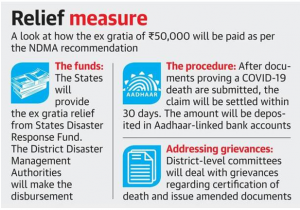
SOURCE: TH
THE CONTEXT: The “world’s largest stockpile” of rhino horns was consigned to flames in eastern Assam’s Bokakhat, the headquarters of the Kaziranga National Park and Tiger Reserve, amid Vedic rituals. The event timed with World Rhino Day was aimed at dispelling myths that have driven the illegal horn trade and the poaching of the animal.
ANALYSIS:
INDIAN RHINO VISION 2020 (IRV 2020)
ONE-HORNED RHINOS
SOURCE: TH
THE CONTEXT: The World Health Organisation (WHO), in its first-ever update since 2005, has tightened global air pollution standards.
ANALYSIS:

NATIONAL CLEAN AIR PROGRAMME (NCAP)
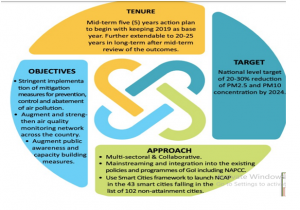
SOURCE: TH
THE CONTEXT: A number of animals and plants have been listed as ‘possibly extinct in the latest edition of the International Union for the Conservation of Nature (IUCN)’s Red List of Threatened Species. The latest edition of the Red List was released at the recently-concluded World Conservation Congress organised by the IUCN at Marseille, France.
ANALYSIS:
SOURCE: DTE
THE CONTEXT: FDI Inflows grow 62% during the first four months of the current Financial Year over the corresponding period last year.
ANALYSIS:
SOURCE: PIB
THE CONTEXT: Towards enhancing military cooperation with friendly nations, Indian Naval Ship INS Tabar was mission-deployed in international waters for over three months from 13 June 21.
ANALYSIS:
SOURCE: PIB
THE CONTEXT: In an unexpected move, the United Kingdom added Indian-made Covishield to its list of recognised vaccines, but refused to recognise vaccine certificates given to those administered the vaccine in India.
ANALYSIS:
SOURCE: TH
THE CONTEXT:A meeting of foreign ministers from the South Asian Association for Regional Cooperation (SAARC) countries, which was set to be held in New York, has been cancelled. The member states were unable to agree upon the participation of Afghanistan, with Pakistan and India in particular at loggerheads over the issue.
ANALYSIS:
SOURCE: TH
Which of the following species of rhino are critically endangered?
Select the correct answer using the code given below:
a) 1 and 2 only
b) 1, 2 and 3 only
c) 1, 2 and 4 only
d)1, 4 and 5 only
ANSWER: C
Explanation:
The reproduction number, or R, refers to how many persons an infected person infects on average. In other words, it shows how ‘efficiently’ a virus is spreading
[WpProQuiz 53]
THE CONTEXT: eSanjeevani, Government of India’s National Telemedicine Service, has completed 1.2 crores (120 lakh) consultations rapidly shaping into the country’s most popular and the largest telemedicine service.
ANALYSIS:
ABOUT e-SANJEEVANI
SOURCE: PIB
THE CONTEXT: According to a new study published by the Pew Research Center, the religious composition of India’s population since Partition has remained largely stable, with both Hindus and Muslims, the two largest religious groups, showing not only a marked decline but also a convergence in fertility rates.
ANALYSIS:
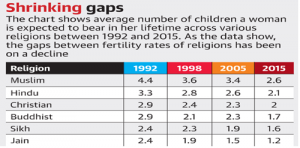
SOURCE: TH
THE CONTEXT: The Centre has started the process to revise school textbooks by appointing former Indian Space Research Organisation (ISRO) Chairman K. Kasturirangan as the head of a 12-member steering committee responsible for developing a new National Curriculum Framework (NCF).
ANALYSIS:
SOURCE: TH
THE CONTEXT: According to experts, the R-value, dropped to 0.92 by mid-September after spiralling over one in August-end.
ANALYSIS:
SOURCE: TH
THE CONTEXT: According to the Quick Estimates released by the Directorate General of Commercial Intelligence and Statistics (DGCI&S), the overall export of Agricultural and Processed Food Products Export Development Authority (APEDA) products has witnessed 21.8 per cent growth in terms of USD during April-August 2021 over the same period of the previous year.
ANALYSIS:
SOURCE: PIB
THE CONTEXT: The coveted International eco-label “Blue Flag”, has accorded the Blue Flag Certification for 2 new beaches–Kovalam in Tamil Nadu and Eden in Puducherry beaches.
ABOUT BLUE FLAG CERTIFICATION
ABOUT BEAMS
SOURCE: PIB
THE CONTEXT: Researchers at the Indian Institute of Technology (IIT), Guwahati, have developed a new class of super-hydrophobic cotton composite with Metal-Organic Framework (MOF) that promise marine oil-spill clean-up in near future.
ANALYSIS:
SOURCE: DTE
THE CONTEXT: Researchers at the Indian Institute of Technology (IIT), Guwahati, have developed a new class of super-hydrophobic cotton composite with Metal-Organic Framework (MOF) that promise marine oil-spill clean-up in near future.
ANALYSIS:
SOURCE: DTE
THE CONTEXT: India could impose “reciprocal measures” on the United Kingdom if London maintained the current quarantine policy that subjected Indian travellers “irrespective of vaccination status” to a quarantine period lasting 10 days.
ANALYSIS:
SOURCE: TH
In the terminology related to the COVID-19 pandemic, which of the following best explains the ‘R’ value?
a) How many infected persons have recovered in one-day
b) How many persons are re-infected by the COVID-19 virus on average
c) How many persons an infected person infects on average.
d) How many persons are vaccinated in one day
Answer: C
Explanation:
COVID-19 Vaccines Global Access, abbreviated as COVAX, is a worldwide initiative aimed at equitable access to COVID-19 vaccines directed by Gavi, the Vaccine Alliance (Global Alliance for Vaccines and Immunization, or GAVI), the Coalition for Epidemic Preparedness Innovations (CEPI), and the World Health Organization (WHO).
| [WpProQuiz 52] |
THE CONTEXT: Project Fulwari under Azadi ka Amrit Mahotsav to Strengthen Northern Coalfields’ Limited (NCL)fight against Malnutrition in kids.
ANALYSIS:
SOURCE: PIB
THE CONTEXT: TRIBES INDIA VAN DHAN to expand Online marketing in a big way by tying up with Big Basket, MoU Signed between TRIFED and Big Basket.
ANALYSIS:
SOURCE: PIB
THE CONTEXT: The Botanical Survey of India, in its new publication Plant Discoveries 2020 has added 267 new taxa/species to the country’s flora.
ANALYSIS:
SOURCE: TH
THE CONTEXT: India scores 46th rank in the Global Innovation Index 2021.
ANALYSIS:
SOURCE: PIB
THE CONTEXT: India will resume the export of COVID-19 vaccines under its ‘Vaccine Maitri’programme to fulfil the commitment towards COVAX (COVID-19 Vaccines Global Access).
ABOUT COVAX:
SOURCE: TH
THE CONTEXT: Indian navy and Indonesian navy participate in exercise ‘Samudra shakti’.
ANALYSIS:
SOURCE: PIB
THE CONTEXT: The 15th India-Nepal combined battalion-level military training exercise ‘SURYA KIRAN’ commenced at Pithoragarh (UK).
ANALYSIS:
SOURCE: PIB
THE CONTEXT: 6th edition of SCO exercise “peaceful mission – 2021” commences at Orenburg, Russia.
ANALYSIS:
SOURCE: PIB
COVAX initiative is started for equitable access of COVID-19 vaccines to all countries. This initiative is led by which of the following?
Select the correct answer using the code given below:
a) 1 and 4 only
b) 1, 2 and 4 only
c) 1, 3 and 4 only
d) All of them
Answer: A)
Explanation:
A variant of HELINA (Helicopter based NAG) Weapon System called DHRUVASTRA is being inducted into the Indian Air Force (IAF).
| [WpProQuiz 51] |
THE CONTEXT: As many as 3.92 lakh lives have been lost in three years in deaths due to negligence related to road accidents, the National Crime Records Bureau (NCRB) revealed in its annual ‘Crime India’ report for 2020.
ANALYSIS:
SOURCE: TH
THE CONTEXT: The Rajasthan Compulsory Registration of Marriages (Amendment) Bill, 2021 was passed in the state assembly. The bill has a provision that requires child marriages to be registered within 30 days.
ANALYSIS:
SOURCE: INDIATODAY
THE CONTEXT: World’s longest expressway between Delhi and Mumbai to open in March 2023. Union Minister for Road Transport and Highways concluded the two-day review of the work progress on the 1380-km eight-lane Delhi-Mumbai Expressway, which will reduce travel time between certain cities to 12-12.5 hours from 24 hours.
SOURCE: IE
THE CONTEXT: Centre to Simplify Coffee Act and promote ease of doing business.
ANALYSIS:
SOURCE: PIB
THE CONTEXT: On his recent visit to India ahead of the U.N. Climate Change conference in Glasgow, U.S. Special Presidential Envoy for Climate John Kerry said he had not received any assurance that India was working to raise its ambition to cut carbon dioxide emissions.
ANALYSIS:
HOW ARE OTHER BIG COUNTRIES PURSUING NET-ZERO?
SOURCE: TH
THE CONTEXT: The Union Cabinet approved a 30,600-crore rupees backstop facility for guaranteeing securities to be issued by the National Asset Reconstruction Company Ltd. (NARCL), the so-called ‘bad bank’ that is being set up to help aggregate and consolidate lenders’ non-performing assets (NPAs) or bad loans.
SOURCE: PIB
THE CONTEXT: The helicopter-launched Nag Anti-Tank Guided Missile (ATGM), HELINA (Helicopter based NAG), being developed indigenously, has completed all trials and the process for issuing of acceptance of necessity (AoN) by the Army.
ANALYSIS:
SOURCE:TH
THE CONTEXT: Researchers from the Department of Material Engineering, Indian Institute of Science, Bengaluru (IISc) have found a way to make a substitute for single-use plastic.
ANALYSIS:
SOURCE: TH
1. Which of the following is the Helicopter based NAG variant being inducted into Indian Airforce?
a) DHRUVASTRA
b) PROSPINA
c) NAMICA
d) MPATGM
Q1.Answer: c)
Explanation:
| [WpProQuiz 50] |
THE CONTEXT: Union Minister Dr Jitendra Singh launches countrywide free Telemedicine facility to mark “Seva Samarpan Abhiyaan” on the occasion of the birthday of Prime Minister Shri Narendra Modi
ANALYSIS:
SOURCE: PIB
THE CONTEXT: TRIFED, FITT and Rusicaa Beverages have entered into a Memorandum of Understanding (MoU) to work together to enhance the income of tribals of Jharkhand through the commercial production and sale of Mahua Nutra beverage, a value-added product made out of Mahua flowers in the state.
ANALYSIS:
SOURCE: PIB
THE CONTEXT: The Indian Railways is heading for a major restructuring plan that could lead to the closure of major establishments, the merger of decades-old organisations and private participation in the running of its schools and hospitals.
ANALYSIS:
SOURCE: TH
THE CONTEXT: The Supreme Court Collegium, led by Chief Justice of India (CJI) N.V. Ramana, is proceeding with staggering speed to fill the vacancies and strengthen the judiciary as seen in the latest slew of recommendations, which include eight new Chief Justices to High Courts, the transfer of five High Court Chief Justices and the shuffling of 28 High Court judges across the country.

SOURCE: TH
THE CONTEXT: U.S. President Joe Biden announced the Global Methane Pledge, a U.S. – EU led effort to cut methane emissions by a third by the end of this decade.
ABOUT METHANE GAS
SOURCE: TH
THE CONTEXT: The GST Council’s 45th meeting was held in Lucknow under the chairmanship of the Union Finance & Corporate Affairs Minister Smt. Nirmala Sitharaman.
RECOMMENDATIONS
SOURCE: PIB
THE CONTEXT: MyGov India, under the Ministry of Electronics and Information Technology (MeitY), has launched the Planetarium Innovation Challenge for Indian start-ups and tech entrepreneurs.
ANALYSIS:
SOURCE: PIB
THE CONTEXT: According to the MEA, Mr Jaishankar once again stressed that peace and tranquillity along the LAC, which depended on resolving all the remaining issues of the 17-month-long stand-off.
ANALYSIS:
SOURCE: TH
THE CONTEXT: “The first issue is that the change of authority in Afghanistan was not inclusive and this happened without negotiation. This raises questions on the prospects of recognition of the new system. Representation of all sections of Afghans, including women and the minorities, is important,” Mr Modi said in a speech at the Afghanistan-themed outreach summit between the Shanghai Cooperation Organisation (SCO) and the Collective Security Treaty Organisation (CSTO).
ANALYSIS:
ABOUT SCO:
ABOUT CSTO
SOURCE: TH
Q1. Consider the following statements about methane gas:
Which of the given statements are correct?
a) 1 and 2 only
b) 2 and 3 only
c) 1 and 3 only
d) 1, 2 and 3
Q1. Answer: c)
Explanation:
Who can register in the e-Shram (NDUW) Portal?
Any individual satisfying the following conditions can register on the portal:
Not a member of EPFO/ESIC or NPS (Govt. funded)
THE CONTEXT: The report, titled ‘Reforms in Urban Planning Capacity in India’, was released by NITI Aayog.
REFORMS IN URBAN PLANNING CAPACITY: SUMMARY
India is home to 11% of the total global urban population. By 2027, India will surpass China as the most populous country in the world. Unplanned urbanization, however, exerts great strain on our cities. In fact, the Covid-19 pandemic has revealed the dire need for the planning and management of our cities.
Urban planning is the foundation for the integrated development of cities, citizens, and the environment. Unfortunately, it has received due attention so far. The existing urban planning and governance framework is complex, which often leads to ambiguity and a lack of accountability.
The report makes several recommendations that can unblock bottlenecks in the value chain of urban planning capacity in India. Some of them are:
SOURCE: PIB
THE CONTEXT: Atal Innovation Mission (AIM) NITI Aayog in partnership with Dassault Systèmes’ is all set to rave up the innovation and entrepreneurship ecosystem across the country.
ANALYSIS:
SOURCE: PIB
THE CONTEXT: India observes the 27th Global Ozone Day.
ANALYSIS:
SOURCE: PIB
THE CONTEXT: Ministry of Labour & Employment has developed an e-SHRAM portal for creating a National Database of Unorganized Workers (NDUW), which will be seeded with Aadhaar.
ANALYSIS:
WHO CAN REGISTER IN E-SHRAM (NDUW) PORTAL?
Any individual satisfying the following conditions can register on the portal:
WHO IS AN UNORGANISED WORKER?
WHAT IS REQUIRED FOR REGISTRATION?
SOURCE: TH
THE CONTEXT: Paving the way for a major clean-up of bad loans in the banking system, the Cabinet cleared a ₹30,600 crore guarantee programme for securities to be issued by the newly incorporated ‘bad bank’ for taking over and resolving non-performing assets (NPAs) amounting to ₹2 lakh crore.
ANALYSIS:
THE CONTEXT: Indian scientists have developed a new sustainable and affordable solution for converting keratin waste such as human hair, wool, and poultry feathers to fertilizers, pet, and animal feeds.
ANALYSIS:
SOURCE: PIB
THE CONTEXT: Resolution of scientific challenge in calculating chemical abundance in stars can help explore their history better.
ANALYSIS:
SOURCE: PIB
THE CONTEXT: Researchers have developed a technology to produce energy-efficient walling materials using construction and demolition (C&D) waste and alkali-activated binders. These are called low-C bricks, do not require high-temperature firing, and avoid the use of high-energy materials such as Portland cement.
ANALYSIS:
SOURCE: PIB
THE CONTEXT: Australia, the U.K. and the U.S. (AUKUS) have announced their forming a new security alliance that will help equip Australia with nuclear-powered submarines.
WHAT DOES IT MEAN FOR DIFFERENT STAKEHOLDER COUNTRIES?
SOURCE: TH
Q1. E-Shram portal registers workers satisfying certain conditions. Which of the following are correct conditions among them?
Select the correct answer using the code given below
a) 1 only
b) 1 and 2 only
c) 1 and 3 only
d) 1, 2 and 3
Q1. ANSWER: B)
Explanation:
Q2. ANSWER: B)
[WpProQuiz 49]
THE CONTEXT: Sansad TV, a news channel combining Lok Sabha TV and Rajya Sabha TV, was launched by the PM.
ANALYSIS:
ABOUT LOK SABHA TV
ABOUT RAJYA SABHA TV
SOURCE: TH
THE CONTEXT: NITI Aayog, with RMI and RMI India’s support, launched Shoonya—an initiative to promote zero-pollution delivery vehicles by working with consumers and industry. The campaign aims to accelerate the adoption of electric vehicles (EVs) in the urban deliveries segment and create consumer awareness about the benefits of zero-pollution delivery.
ANALYSIS:
SOURCE: PIB
THE CONTEXT: Villagers living near Deepar Beel (Assam), a Ramsar Site wetland and Important Bird Area under stress, have opposed the proposed realignment of a railway track skirting its southern edge.
ANALYSIS:
SOURCE: TH
THE CONTEXT: India is expected to grow at 7.2 per cent in 2021 but economic growth could decelerate next year, according to a United Nations report which said the recovery in the country is constrained by the ongoing human and economic cost of the COVID-19 pandemic and the negative impact of food price inflation on private consumption.
ANALYSIS:
SOURCE: TH
THE CONTEXT: The Union Cabinet approved a number of structural and process reforms in the Telecom sector. These are expected to protect and generate employment opportunities, promote healthy competition, protect the interests of consumers, infuse liquidity, encourage investment and reduce the regulatory burden on Telecom Service Providers (TSPs).
ANALYSIS:
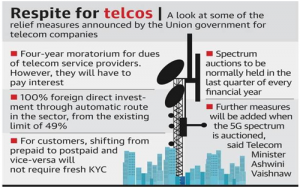
STRUCTURAL REFORMS
PROCEDURAL REFORMS
ADDRESSING LIQUIDITY REQUIREMENTS OF TELECOM SERVICE PROVIDERS
THE CONTEXT: The Central Government has approved the Production-Linked Incentive (PLI) scheme for drones and drone components.
SALIENT FEATURES OF THE PLI SCHEME FOR DRONES
SOURCE : PIB
THE CONTEXT: A week before a meeting of Quad leaders in Washington DC, the Biden administration, announced a new trilateral security partnership for the Indo-Pacific between Australia, the U.K. and the U.S. (AUKUS).
ANALYSIS:
SOURCE: TH
Q1. A new trilateral security partnership ‘AUKUS’ has been recently announced between which of the following three countries?
a) Argentina, U.K. and U.S.
b) Australia, U.K. and U.S.
c) Australia, the Kingdom of Saudi Arabia and the U.S.
d) Australia, South Korea and the U.S.
Q2. “Shoonya Campaign” launched by Niti Aayog is related to:
a) Improving learning abilities among primary school students.
b) Electric vehicles
c) Women empowerment
d) Culture and history
Answer: D
Explanation:
[WpProQuiz 48]